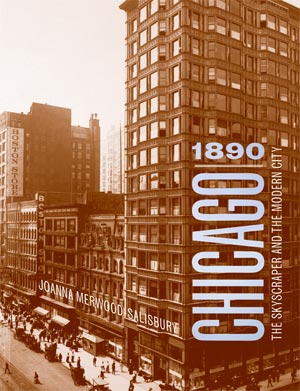
This book is about the first skyscrapers in the world, those built in Chicago in the 1880s and 90s. The unprecedented sixteen-story buildings lining La Salle and Dearborn Streets gave the world a spectacular image of the future of the modern city: dense, crowded and vertical. Amongst architects, these buildings are famous for the way in which they incorporated and expressed new building technologies (steel-framing, elevators), and rejected traditional ornament in favor of startling simplicity.
My goal in writing this book, however, was to examine these buildings not as icons of architectural history, but in cultural and social context. What did they mean to the people who designed and built them, worked inside their walls, and gazed up at their façades?
Researching the book I uncovered a fierce debate about the meaning of the first skyscrapers in the popular press and in professional journals. While architects and property owners saw these pioneering structures as manifestations of a robust American identity being formed in the Midwest, labor activists viewed them as symbols of capitalism’s inequity, and social reformers worried about their potentially negative effects on public health.
“As much as architects justified the skyscraper as the finest product of the city, socialists and anarchists denounced it as a symbol of class oppression and economic inequality.”
Although I was trained as a professional architect, I am principally an architectural historian, drawn especially to the social and political context of architecture and urbanism in nineteenth and early twentieth century America. My aim is always to investigate buildings not as autonomous aesthetic objects, but as the physical manifestations of culture and society. In this way my research ranges far from the traditional approach that focuses on individual architects and aesthetic analysis towards a more inclusive understanding of the meaning of buildings, not only for architects and critics, but also for the people who build and occupy them.
Chicago 1890 reflects this approach. The book is firstly a reinterpretation of some well-known architectural masterpieces by Chicago architects Louis Sullivan, Dankmar Adler, Daniel Burnham, and John Wellborn Root, notably the Monadnock (1885-92) and the Reliance Building (1889-95). I examine these buildings not only as important artifacts in architectural history, but also as sites for a contentious debate about the future of the industrial city.
Chicago’s defining events, including the violent building trade strikes of the 1880s, the Haymarket bombing of 1886, the World’s Columbian Exposition of 1893, and Burnham and Bennett’s 1909 Plan of Chicago— feature large in the book as the context in which the skyscraper, at the turn of the twentieth century, was imagined, built, and finally repudiated. This approach to architectural history provides a new way to look at the work of important American architects, understanding their designs as specific responses to modern urban phenomena.
One of the most revered buildings in Chicago’s architectural history is also one of the strangest. Looming over the intersection of Dearborn and Jackson Streets, Burnham’s and Root’s Monadnock building, completed in 1892, is a massive pile of purple-brown brick rising vertiginously to 16 stories above the sidewalk to a gently curving cornice line above, ornamented only by punched rectangular windows. The Monadnock is famous as the highest building erected with solid masonry walls. Utilizing an ancient method of building construction, but exhibiting no attempt at ornamentation beyond its highly unusual color and the sculpted effect of its brick, the Monadnock seems both archaic and entirely modern at the same time.
By 1889 south Dearborn Street was home to the tallest and most innovative skyscrapers in the world. The Chicago Tribune described the towers rising there as “the finest structures in the city.” The startling effect of the Monadnock was a bold experiment in urban design, one that took its aesthetic cues from its busy context.
In his writing on the design of the tall office building, John Wellborn Root imagined an entirely new aesthetic for crowded Chicago streets. He discussed the possibility of an architecture whose effect depended on color rather than ornament. The business block should be monolithic and plain, he said, since metropolitan dwellers were too busy to appreciate fine detail. Thinking of his audience, those who would pass by the new buildings, he wrote, “each detail in a building goes for little with the general public, and they are more impressed by the use of certain materials, by the general arrangement of masses, by the effect of lightness or solidity” than by the fine quality of its historical references. In other words, the tall office building should not force itself upon the city dweller’s consciousness; it should simply be a dignified subliminal presence, a familiar and unassuming backdrop to the frenzy of activity on the sidewalk.
In formulating his ideas about skyscraper design, Root borrowed liberally from debates about form and color, figuration and abstraction, in contemporary painting. His proposal that tall office buildings rely on the “art of pure color” rather than traditional ornamental scheme, for example, is directly related to his great admiration for the painter James McNeill Whistler’s experiments with tonal harmony. This approach, along with criticism that valued the tall office building as a simple and somber backdrop to the shifting scenes of modern life, provides us with a new category of analysis for the early Chicago skyscraper: the perception of the modern subject.
“John Wellborn Root imagined an entirely new aesthetic for crowded Chicago streets. He discussed the possibility of an architecture whose effect depended on color rather than ornament. The business block should be monolithic and plain, he said, since metropolitan dwellers were too busy to appreciate fine detail.”
Between the 1870s and 90s the rapid growth of Chicago was interrupted by fierce conflict. Violent strikes and demonstrations over wages and labor conditions were met with brutal responses on the part of business leaders, the police, and local militia. These disputes involved not only class divisions but ethnic divisions as well, since the laborers toiling to build the new city were largely recent immigrants, first from Ireland, then from Central, Eastern, and Northern Europe. Together with an uncompromising war of words in newspapers and broadsheets, these events created an intensely hostile urban environment, an environment that almost succeeded in bringing the city to a standstill. For Chicagoans, mindful of recent events in Germany, France, and Russia, the threat of social revolution was real. It was reflected in all areas of life, including emerging urban form. As much as architects justified the skyscraper as the finest product of the city, socialists and anarchists denounced it as a symbol of class oppression and economic inequality.
At the same time, Chicagoans were forced to confront the environmental consequences of their transformation of the land. Despite the rhetoric of organism, the built environment and the natural world did not operate in harmony. The founding of the industrial city meant radical changes to the region’s natural ecology. The topography was altered to provide adequate foundation for roads and buildings. The river and the lake became polluted. High concentrations of people living in squalid slums led to major epidemics. The magnificent vista of Chicago was obscured by clouds of coal-smoke pouring from the roof of each new building. All of this environmental change necessitated new ways of thinking about architecture and urban design if the city and its citizens were to survive.
By the turn of the twentieth century, the heroic image of the skyscraper city was all but abandoned. The 1893 World’s Columbian Exposition and Burnham and Edward Bennett’s 1909 Plan of Chicago presented a new agenda for urban design. The skyscraper, now seen as the expression of laissez-faire capitalism and dangerous individualism, was replaced with a unified and horizontal civic image. The era of the skyscraper, in existence for less than twenty years, seemed dead.


Joanna Merwood-Salisbury is Assistant Professor of Architectural History at the School of Constructed Environments, Parsons The New School for Design. An architect by training, she received her Ph.D. in architectural history and theory from Princeton University in 2003. Her scholarly focus is nineteenth-century architecture and urbanism in the United States. She has published articles and reviews in the Journal of the Society of Architectural Historians, the Journal of Architectural Education, Technology and Culture, Design Issues, Grey Room, and Lotus International. Her current project is a history of Union Square in New York, seen as a stage for public celebration and protest.